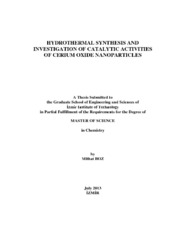Please use this identifier to cite or link to this item:
https://hdl.handle.net/11147/3610Full metadata record
| DC Field | Value | Language |
|---|---|---|
| dc.contributor.advisor | Eanes, Mehtap | en |
| dc.contributor.advisor | Çağır, Ali | en |
| dc.contributor.author | Boz, Mithat | - |
| dc.date.accessioned | 2014-07-22T13:51:56Z | - |
| dc.date.available | 2014-07-22T13:51:56Z | - |
| dc.date.issued | 2013 | en |
| dc.identifier.uri | http://hdl.handle.net/11147/3610 | - |
| dc.description | Thesis (Master)--İzmir Institute of Technology, Chemistry, İzmir, 2013 | en |
| dc.description | Includes bibliographical references (leaves: 59-62) | en |
| dc.description | Text in English; Abstract: Turkish and English | en |
| dc.description | xi, 70 leaves | en |
| dc.description | Full text release delayed at author's request until 2016.08.20 | en |
| dc.description.abstract | Single crystalline cerium oxide nanoparticles were synthesized with hydrothermal method by mixing cerium nitrate [Ce(NO3)3.6H2O] aqueous solution with NaOH and urea. SEM, TEM and XRD characterization methods were used in order to identify morphology. First part of the study includes the work on effect of hydrothermal parameters, such as base type and concentration, surfactant, reaction temperature, and time on particle size and morphology. The reaction time, temperature and concentration trials were carried out for urea only. When base types were compared, smaller particles were synthesized in the presence of NaOH yet smaller crystalline sized particles were obtained in the presence of urea. Effect of surfactant was investigated however there was no significant effect on size or morphology. Effect of concentration was clear, cubic and triangular prism shaped particles obtained for concentrations lower than 1M, and for concentration higher than 1M, agglomerated spherical particles were obtained. Reaction time and temperature were also investigated and all the reactions resulted in agglomerated non-uniform spherical particles. There was no considerable difference in particle and crystalline size for these samples. Due to the sub-micron size of CeO2 synthesized using urea, CeO2 nanoparticles synthesized using NaOH for catalysis. Second part includes the investigation of catalytic property of CeO2 nanoparticles. CeO2 nanoparticles were used as catalyst in the synthesis of flavone from 2‟-hydroxychalcone. Total flavone yield was approximately 42.5 %. Several reaction parameters were studied in order to achieve the flavone synthesis. TLC, GC-MS and NMR were used in order to monitor the results of the reactions. | en |
| dc.language.iso | en | en_US |
| dc.publisher | Izmir Institute of Technology | en |
| dc.rights | info:eu-repo/semantics/openAccess | en_US |
| dc.subject.lcsh | Cerium oxides | en |
| dc.subject.lcsh | Thermochemistry | en |
| dc.subject.lcsh | Nanoparticles | en |
| dc.title | Hydrothermal synthasis and investigation of catalytic activities of cerium oxide nanoparticles | en_US |
| dc.type | Master Thesis | en_US |
| dc.institutionauthor | Boz, Mithat | - |
| dc.department | Thesis (Master)--İzmir Institute of Technology, Chemistry | en_US |
| dc.relation.publicationcategory | Tez | en_US |
| item.fulltext | With Fulltext | - |
| item.grantfulltext | open | - |
| item.languageiso639-1 | en | - |
| item.openairecristype | http://purl.org/coar/resource_type/c_18cf | - |
| item.cerifentitytype | Publications | - |
| item.openairetype | Master Thesis | - |
| Appears in Collections: | Master Degree / Yüksek Lisans Tezleri | |
Files in This Item:
| File | Description | Size | Format | |
|---|---|---|---|---|
| 10013144.pdf | MasterThesis | 4.07 MB | Adobe PDF |  View/Open |
CORE Recommender
Page view(s)
244
checked on Nov 18, 2024
Download(s)
124
checked on Nov 18, 2024
Google ScholarTM
Check
Items in GCRIS Repository are protected by copyright, with all rights reserved, unless otherwise indicated.